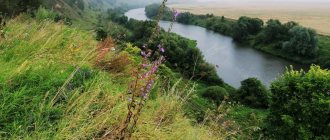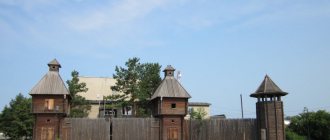| Latin name: | Aquila |
| English name: | To be confirmed |
| Kingdom: | Animals |
| Type: | Chordata |
| Class: | Birds |
| Squad: | Accipitridae |
| Family: | Accipitridae |
| Genus: | Eagles |
| Body length: | 75-88 cm |
| Wing length: | 2500 cm |
| Wingspan: | 180—230 cm |
| Weight: | 3000—7000 g |
In ancient times, the eagle was a symbol of the sun in Egypt and China; the bird was believed to bring good luck and victory. For the Romans, the eagle served as the personification of the storm and lightning of Jupiter. The rulers of ancient countries often wore decorations made of eagle feathers or added corresponding symbols to their clothes. The image of the eagle is reflected even in world religions. This proud bird, which is distinguished by its flight height, is considered the embodiment of the divine face in Hinduism, Christianity and other religions.
Description of the bird
— Advertising —
The eagle is a bird of prey that belongs to the hawk family. This is a bird with a massive build, long, wide wings, and a massive beak. The eagle's claws are curved inward, and feather “pants” are located in the hip area.
The eagle's body length is from 75 to 88 cm, the tail is short, the wings are wide, their span reaches 2.5 m.
Automobile highways
Federal highways pass through Orel:
- M2 "Crimea" is a highway that has the status of an object of federal significance. It is part of the European route E105. The total length of the route is 720 km. The road originates in Moscow and passes through Tula, Belgorod, Orel, Kursk. The final point of the M-2 route is the state border with Ukraine. The road surface of the route is concrete and asphalt.
- P120 is a public highway of federal significance, the total length of which is 445 km. The route begins in the city of Orel and passes through Rudnya, Bryansk, Smolensk. The final point of the road is the state border with Belarus. The road surface of the route is concrete and asphalt.
- P119 is a federal highway with a total length of 395 km. The route starts in Orel and passes through Lipetsk, Livny, Yelets. The final point of the route is the M6 Caspian highway, Tambov region. The road surface is asphalt.
- P92 is a federal highway with a total length of 206 km. The highway passes through the following regions of Russia: Oryol region, Kaluga region, Tula region. The road surface of the route is gravel, asphalt.
- E105 is a European route that starts in the Norwegian city of Kirkenes and passes through Tver, Moscow, Petrozavodsk, St. Petersburg, Kharkov, Tula, Simferopol, Kursk, Belgorod, Veliky Novgorod, Zaporozhye. The final point of the European route E105 is Yalta.
Dietary features of the eagle
The eagle's diet is based on small and medium-sized vertebrates; the bird can rarely feed on carrion.
— Advertising —
Eagles hunt very effectively. In search of prey, these birds can soar in the air for a long time, or they look out for their victims, sitting on elevated places. Eagles are excellent at hunting other birds. They always overtake their prey by surprise, as they attack from such a height at which the victim simply does not see them. The eagle also dives with great speed, which leaves the prey no chance of escape. This is how eagles catch birds in flight.
In addition to independently obtaining food, eagles are also prone to robbery - they easily take caught prey from small birds of prey right on the fly.
Population gain or loss according to the census
The total and official population of the city of Oryol, how many people live in it as of January 1, 2022, the number of people in each individual urban district and municipality, further in the second table.
| Year | Growth/decrease population city of Orel |
| 2017 | ↘318,633 people |
| 2018 | ↘315,308 people |
| 2019 | ↘311,625 people |
| 2020 | ↘308,838 people |
| 2021 | ↘303,696 people |
| 2022 |
Common Eagle Species
Hawk eagle (Aquila fasciata)
The body length of this species is from 65 to 75 cm, the wing length is from 46 to 55 cm, the weight is in the range of 1.5-2.5 kg. The plumage of adult birds is blackish-brown on the back, the tail is gray with a transverse dark pattern. The belly is buffy or white with black longitudinal streaks and dark transverse stripes on the legs and undertail. Juveniles have a reddish abdomen with streaks on the chest, head and neck. The iris is yellow in adults, light brown in young ones. The beak is grayish-black, the claws are black, the legs are yellow. Females are larger than males.
The hawk eagle lives in the tropics and subtropics of Southern Europe, Africa, Asia, and the Lesser Sunda Islands.
In many regions of Europe, this species is endangered, as it is being exterminated by humans, its habitat is changing with a decrease in its usual food, and birds also often die on power lines.
Pygmy eagle (Aquila pennata)
The bird's body length is from 45 to 53 cm, its wingspan is 100-132 cm, its weight is from 500 to 1300 g. Females are larger than males, but are identical in plumage color. The tail is light below, without stripes. The beak is short, curved, black. Paws are yellow with black claws.
In plumage for the dwarf eagle, a distinction is made between light and dark varieties. The light dwarf eagle has a brown back, a dirty white belly, and dark streaks on its chest. The wings are dark above and light below. Eagles are dark brown-brown on both the back and belly, with a golden or red tint on the head.
The species is found in northwestern Africa (from Morocco to Tunisia). In Europe, the bird lives on the Iberian Peninsula and France. Individual nesting sites are found in Greece, Turkey, Bulgaria, Romania, Slovakia, Moldova, Belarus, Ukraine, Russia, Mongolia, and India. The populations living in India lead a sedentary lifestyle, the rest are migratory. For life, the dwarf eagle chooses deciduous, rarely coniferous and mixed tall-stemmed forests located next to open spaces.
Indian hawk eagle (Aquila kienerii)
A small species with a body length from 46 to 61 cm, a wingspan of 105-140 cm. The wings are pointed and narrow. The tail is rounded and long. Adult birds have black back and sides. The chin, neck and crop are white. The underparts, legs and wings are reddish-brown with wide black stripes. The tail and wings below are gray with dark transverse stripes. There is a crest on the head. The beak is black, the iris is dark brown. Paws are yellow with black claws. It does not have sexual dimorphism.
The species is distributed in the Indomalayan zone (Indian subcontinent, Indochina, Malaysia, western Indonesia, Philippines), where it lives in tropical, evergreen, and moist forests.
Stone eagle (Aquila rapax)
The body length of the species is from 60 to 72 cm. The wingspan is 60-183 cm. The weight of males is 1.6-2.0 kg, females - 1.6-2.5 kg. The iris is yellow or light brown, the legs are yellow. The wings are wide, the tail is short. Based on the color of the plumage, light, dark and red morphs are distinguished.
The bird is found in Asia (Iran, Pakistan, India, Nepal, Myanmar), in western Africa (Chad, Sudan, Ethiopia, Somalia), as well as in Namibia and Botswana, South Africa, Lesotho and Swaziland. The stone eagle lives in savannas and steppes, at altitudes up to 3000 meters above sea level.
Steppe eagle (Aquila nipalensis)
The bird's body length is from 60 to 85 cm, its wingspan is 220-230 cm, its weight is from 2.7 to 4.8 kg. Females are larger than males. The plumage of adult birds is dark brown, with a rufous spot on the back of the head. The wings are gray-brown. The iris is nut-brown, the beak is grayish-black, the claws are black, the paws are yellow. Young birds have a brownish-buffy color with streaks.
The steppe eagle nests in the Stavropol Territory, Orenburg Region, Kalmykia, Astrakhan and Rostov Regions of Russia, in the south of the Urals, in Siberia, and Asia. The species is migratory, winters in Africa, India, and the Arabian Peninsula. The bird is listed in the Red Book of the Russian Federation and is an endangered species.
Greater Spotted Eagle (Aquila clanga)
Body length from 65 to 73 cm, weight 1.6-3.2 kg. Sexual dimorphism manifests itself only in the fact that females are larger than males. The Greater Spotted Eagle is larger and darker than the Lesser Spotted Eagle, but in general it is difficult to tell them apart. The plumage of adult individuals is dark brown, with a light nape and undertail. Young birds have light teardrop-shaped spots on their backs. The beak and claws are black. Paws are yellow.
The species lives in Europe (Finland, Poland, Hungary, Romania) and Asia (Mongolia, China, Pakistan). In Russia it is distributed from Kaliningrad to Primorye. The bird is migratory and migrates to India, Iran, and Indochina for the winter.
Lesser Spotted Eagle (Aquila pomarina)
Body length from 62 to 65 cm, weight 1.5-1.8 kg. The plumage color is the same as that of the Greater Spotted Eagle, but slightly lighter.
It lives in Russia in two regions: near St. Petersburg, Novgorod, Moscow and Tula regions. Also found in Hungary, Macedonia, Greece, Turkey, Iraq, India.
Indian Spotted Eagle (Aquila hastata)
The bird's body length is up to 65 cm. It is a stocky predator with a large head, short, wide wings and a short tail. The plumage is brown.
Its habitat includes countries such as Bangladesh, Myanmar, Cambodia, India, and Nepal.
Kafa eagle (Aquila verreauxii)
Body length is from 70 to 95 cm, weight is in the range of 3.5-4.5 kg, wingspan is up to 2 m.
The Kaf eagle is distributed in Africa, from the south of Chad to Fynbos and the Drakensberg Mountains, where it nests in dry areas.
Moluccan eagle (Aquila gurneyi)
Body length is 74-85 cm, wingspan is from 170 to 190 cm, weight reaches 3 kg. The species is distinguished by a very long tail.
Distributed in Indonesia and Papua New Guinea, where it inhabits pristine forests at altitudes up to 1500 meters above sea level. The population of this species is small.
Silver eagle (Aquila wahlbergi)
The body length of the bird is from 55 to 60 cm, the wingspan is 130-160 cm. The bird is widespread in Africa south of the Sahara.
Wedge-tailed eagle (Aquila audax)
Body length is up to 1 m, wingspan is about 2.3 m. Females are larger than males, their weight reaches 4-5 kg. Males weigh up to 3-4 kg. The species lives in Australia, Tasmania and southern New Guinea, in the mountains and plains.
Population in municipal, urban areas
Located 368 km southwest of Moscow, on the Central Russian Upland in the European part of Russia, on both banks of the Oka River and its tributary Orlik.
Folk etymology connects the name of the city with the events that allegedly occurred during its founding in 1566.
At the behest of Tsar Ivan the Terrible, the construction of a fortified city began to protect the southern borders of the Russian state from attacks by the Crimean Tatars.
When they began to cut down an oak tree that grew on the bank at the confluence of the two rivers Oka and Orlik, an eagle flew from the top of the tree. “And here is the owner,” said one of the men.
Ivan Vasilyevich ordered to name the city after the bird.
The city's climate is moderate continental. Winter is moderately cold. Its first half is somewhat softer than the second, with frequent thaws.
Now we will tell those interested in the climate in the city of Oryol what the average temperature was according to research over the past few years, the maximum and minimum values, as well as the average and norms of precipitation:
Climate of Orel (weather, precipitation)
| Index | Jan. | Feb. | March | Apr. | May | June | July | Aug. | Sep. | Oct. | Nov. | Dec. | Year |
| Abs. Max. | 7 | 9,4 | 19,3 | 29 | 32,8 | 35,4 | 38,7 | 39,5 | 31,3 | 26,3 | 17,5 | 9,7 | 39,5 |
| Avg. Max. | −3,4 | −1,7 | 4,7 | 12,9 | 20,8 | 24,5 | 26,1 | 25,2 | 20 | 10,9 | 4,6 | 0,2 | 12,1 |
| Avg. pace. | −5,9 | −4,8 | 0,5 | 8 | 15,2 | 18,5 | 20 | 19,3 | 14,5 | 6,8 | 1,1 | −2,7 | 7,5 |
| Avg. min. | −8,2 | −7,5 | −3,2 | 3,6 | 10,1 | 13,1 | 14,3 | 13,8 | 9,4 | 3,2 | −2,1 | −5,4 | 3,4 |
| Abs. min. | −35,4 | −37,2 | −37,8 | −17,2 | −5 | −0,4 | 3,9 | −2,2 | −5 | −13 | −26,4 | −35 | −37,8 |
| Norm of siege. | 43 | 38 | 34 | 43 | 42 | 69 | 76 | 60 | 61 | 55 | 43 | 43 | 605 |
Whether the population of the city of Orel is decreasing or increasing, what is its official number according to the census as of January 1, 2022, in its municipalities, urban areas, we will learn about this later, when accurate information appears, for now we will present the currently available figures.
Date of foundation of Orel: 1568
Time zone: MSK, UTS +3
Eagle breeding
Eagles are monogamous birds that mate for life. The eagle's nest is large and strong, built from branches, at the maximum height for the area. Eagles use the same nest for many years in a row, building and expanding it.
Eagles usually have 2 eggs in one clutch. The female incubates them, and the male obtains food for her and for himself. Newborn chicks are covered with down. From a very young age, eagles learn to survive; very often the larger chick pushes the younger ones out of the nest, or kills them in the fight for food. If there is enough food, both chicks survive.
While the chicks are small, the male gets food, and the female raises and feeds the offspring, and also protects the nest. At the age of 3 months, eaglets begin to fly out to hunt. And after a few months they begin to live independently.
What is the population of the city of Orel?
| Urban district - the city of Orel | 303 696 | 303 696 | 0 |
| Orel | 303 696 | 303 696 | 0 |
| including inner city areas | |||
| Zheleznodorozhny district | 60 278 | 60 278 | 0 |
| Zavodskoy district | 103 288 | 103 288 | 0 |
| Northern region | 65 815 | 65 815 | 0 |
| Sovetsky district | 74 315 | 74 315 | 0 |
With the population of the city of Orel as of January 1, 2022, how many people live in this territory, people in municipalities and this locality, this territorial unit of the Russian Federation, that’s what we figured out here, we made our contribution to satisfying the requests of those interested in this statistical information .
Unfavorable days in 2022, difficult for health and well-being
Lunar calendar for hair cutting 2022, favorable days to cut hair
Interesting facts about the bird
- Eagles very often soar above the ground, but even during such a soar the bird is capable of reaching speeds of 190-240 km/h. The illusion of slow motion occurs due to the flight altitude - more than 700 meters. The eagle dives at speeds of up to 320 km/h.
- The eagle has very sharp vision with a wide range of vision. Each bird's eye focuses on two objects at once (for example, in a person - only on one), and visual acuity allows the bird to see a hare at a distance of more than 3 km. From the height of its flight, the eagle sees prey over an area of 11.5 km. It is interesting that the eyes of eagles are endowed with two eyelids: transparent and dense. Transparent eyelids protect the bird's eyes from strong winds, and the latter are necessary for sleeping.
Orel population census, how many people live on January 1?
What is the official population of Orel for 2022, how many people live according to the census, how many people are in urban areas as of January 1, trends in profit and loss, whether their number is increasing or decreasing, such questions are of interest to many and we will try to get answers to them.
The city of Orel with all its administrative districts is part of the Russian Federation, the administrative center of the Oryol region and the Oryol municipal district (which it is not part of).
We will look into the population of the city of Orel, how many people live as of January 1, 2022, and how many people officially live in urban areas.
Habitat
Eagles are found on various continents; there are quite a lot of them in Russia. The birds are large and have a very negative attitude towards the appearance of strangers in the territory they consider theirs. That is why there should be 10-100 square meters per nest. km area. They prefer open areas: steppes, savannas, and are rarely found in forests and deserts.
Where do they live?
The countries of Africa, Eurasia and North America are where the eagle lives. They prefer to settle at a considerable distance from cities and people, as well as from their fellow creatures. Golden eagles choose forest zones as their habitat, while steppe representatives are more impressed by the steppe or semi-desert. Scavengers are found in Kazakhstan, Ukraine, the Czech Republic, and Romania.
What do they eat?
An eagle is not an animal, but a bird of prey that obtains its food by hunting. Soaring in the air, the formidable bird looks out for game, and when it finds it, it dives down, grabs it with its sharp claws and soars up. Rodents, reptiles, snakes - this is what the eagle eats in natural conditions. However, often the bird has to make do with insects or carrion. The function of the orderly is the destruction of dead animals - this is the role the eagle plays in nature.
Gophers and gerbils are what the steppe eagle eats, but sometimes the proud bird gets only lizards, snakes and small birds.
Lifespan
From 10 to 20 years - this is how many years an eagle lives under favorable circumstances. Birds are now considered rare, which is associated with human economic activity and a reduction in the food supply. Some species are listed in the Red Book and are protected.
Unfortunately, birds rarely live to old age due to lack of food and the activities of poachers
Note! Another factor is the difficulty of reproduction. Individuals are very reluctant to mate in captivity; in addition, there are usually 1-2 eggs in a clutch; chicks appear on average once every 3-5 years.
Migratory bird or not
The description of the eagle bird makes it clear that it can be either migratory or sedentary - it all depends on its habitat. If the bird lives in northern latitudes, then with the onset of cold weather it migrates to warm countries. If the eagle’s homeland is Africa, then it leads a sedentary lifestyle and does not leave its native nest.
Captivity
Most species of eagles are rare, so in order to preserve and increase their numbers, these birds began to be kept in captivity. We are talking about zoos, nature reserves, and nature parks.
Basic goals
There are several of them. Firstly, protecting the species from complete extinction, providing a food supply, and creating relatively safe conditions. Secondly, eagles are kept in zoos so that everyone can see what these proud, beautiful birds look like.
Cages, enclosures
Keeping an eagle in a cage is a mockery of the bird; it is not a canary, but a predator for which the ability to soar in air currents is vital. Therefore, birds are placed in enclosures; the larger the area, the better, because in their natural habitat any eagle will place its nest at a considerable distance from the nest of a relative.
Birds are often kept in pairs, which helps them reproduce. However, in any case, only the most experienced ornithologists can obtain offspring from a proud predator in captivity.
To breed eagles in captivity, it is necessary to create optimal conditions for the birds.
How to breed eagles in captivity
In zoos, when kept in open-air cages, it is difficult to force birds to mate, because for mating games they need the sky, as well as the spirit of competition. That is why relative success has been achieved in breeding birds in zoological parks, where conditions are as close as possible to natural ones.
The birds choose their own mates, obtain food, and the employees’ task is to ensure their protection from hunters and poachers; people do not interfere with the reproduction of birds in any other way. In practice, this option turned out to be the most effective.
How long do they live at home?
The average life expectancy in captivity is 40-45 years. According to ornithologists, this is not the limit.
Note! The record for longevity among eagles is 82 years.









